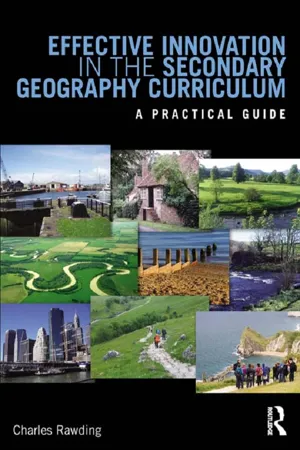
Effective Innovation in the Secondary Geography Curriculum
A practical guide
- 194 pages
- English
- ePUB (mobile friendly)
- Available on iOS & Android
About this book
How up-to-date is your geographical thought? Are parts of your curriculum becoming tired and out-dated?
Effective Innovation in the Secondary Geography Curriculum will help training and practising secondary school teachers understand how to evaluate and refresh their curriculum in order to ensure that what they teach is relevant, topical and creative.
Considering the latest developments in both the school geography curriculum and the field of geography as an academic discipline, this exciting new book explores how geography teaching and learning can be developed to engage secondary school pupils and better reflect contemporary society. Illustrated throughout with ideas and practical examples of how to update your curriculum easily and effectively, key topics covered include:
- Understanding curriculum theory and development;
- Auditing and developing your own dynamic, interactive curriculum;
- Critiquing textbooks and resources to ensure relevance;
- Constructing and analysing schemes of work;
- Incorporating the latest developments in the field into your teaching;
- How to create innovative, enduring curricula for human, physical and environmental geographies.
Providing insights into the latest thinking in geography in a concise and accessible manner, Effective Innovation in the Secondary Geography Curriculum will ensure motivating, lively and successful geography teaching and learning.
Frequently asked questions
- Essential is ideal for learners and professionals who enjoy exploring a wide range of subjects. Access the Essential Library with 800,000+ trusted titles and best-sellers across business, personal growth, and the humanities. Includes unlimited reading time and Standard Read Aloud voice.
- Complete: Perfect for advanced learners and researchers needing full, unrestricted access. Unlock 1.4M+ books across hundreds of subjects, including academic and specialized titles. The Complete Plan also includes advanced features like Premium Read Aloud and Research Assistant.
Please note we cannot support devices running on iOS 13 and Android 7 or earlier. Learn more about using the app.
Information
The changing nature of Geography
The changing nature of academic Geography
Introduction
Changing geographical paradigms
many of the ‘new’ positions have more to do with the sociology of education rather than with the advancement of new knowledge: individuals and groups need new niches to establish their academic credentials even if the new position may in fact be the reworking of an old theme or an oppositional stance with few foundations.
| Dates | Paradigm | Comment |
| Late 19th and early Exploration 20th century | Exploration and discovery, cartography | Strong links to colonialism and imperial expansion |
| Early to mid-20th century | Environmentalism | Determinism, possibilism, and the link between humans and nature |
| Early to mid-20th century | Regionalism | Detailed texts on specific parts of the earth, classifying and subdividing space. |
| 1960s to 1970s | Spatial science | Quantitative revolution — producing general models of development as part of a ‘scientific turn’. |
| 1970s on | A wide variety of competing paradigms | Humanism, structuralism, phenomenological approaches, behavioural approaches, process- and time-based physical geography, post-modernism |
| Section 1: The role of models | |
| Models, paradigms and the new geography | The use of models in science |
| Section II: Models of physical systems | |
| Models in geomorphology | Models in meteorology and climatology |
| Hydrological models and geography | |
| Section III: Models of socio-economic systems | |
| Demographic models and geography | Sociological models in geography |
| Models of economic development | Models of urban geography and settlement location |
| Models of industrial location | Models of agricultural activity |
| Section IV: Models of mixed systems | |
| Regions, models and classes | Organism and ecosystem as geographical models |
| Models of the evolution of spatial patterns in human geography | Network models in geography |
| Section V: Information models | |
| Maps as models | Hardware models in geography |
| Models of geographical teaching |
the quantitative revolution has run its course, and diminishing marginal returns are apparently settling in, yet another piece of factorial ecology, yet another attempt to measure the distance-decay effect, yet another attempt to identify the range of a good, serve to tell us less and less about anything of relevance.
Table of contents
- Cover
- Half Title
- Title Page
- Copyright Page
- Dedication
- Table of Contents
- List of figures
- List of tables
- List of boxes
- Acknowledgements
- Introduction: Effective innovation in the Geography curriculum
- Part 1 The changing nature of Geography
- Part 2 Auditing your curriculum
- Part 3 Developing contemporary geographies
- Notes
- References
- Index